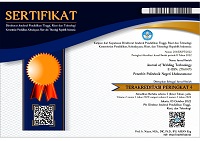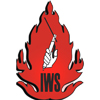Residual Stress Analysis in Pipe Welding ASTM A106 Grade B Using FEM Simulation
Abstract
Fabrication technology has also penetrated the oil and gas industry, such as in the case of joining materials, one of the applications being made is the connection of pipes by welding. In the welding process, the heat distribution is uneven and the cooling rate is fast, resulting in residual stresses. This is indicated by changes in the microstructure in the weld area and the Heat Affecting Zone (HAZ), causing the material to become hard but brittle (brittle). This can cause structural failure in the connection area. This study investigates the residual stresses in pipe welding ASTM A 106 Grade B using the finite element method with ANSYS R17.2 software. The simulation is divided into 2 steps, namely thermal and structural analysis. The variation used in this simulation is the electric current as the welding heat input. The electric current is 110 A with an effective heat input of 2337.5 Watts with a maximum residual voltage of 399.59 MPa, 2762.5 Watts with a current of 130 A of 420.01 MPa, 3400 Watts with a current of 160 A of 454.06 MPa. The simulation shows that an increase in electric current in the range of 110 to 160 A can imply an increase in residual voltage. A welding heat input is obtained with the minimum residual voltage value, namely at a current of 110 A with an effective heat input of 2337.5 watts.
Keywords
Full Text:
PDFReferences
W. Ma, H. Zhang, W. Zhu, F. Xu, and C. Yang, “Study on residual stress of welded hoop structure,” Appl. Sci., vol. 10, no. 8, p. 2838, 2020.
H. Wiryosumarto and T. Okumura, “Teknologi pengelasan logam, PT,” Pradnya Paramita, Jakarta, 2000.
H. Hamdani, “Pengaruh Masukan Panas Proses Pengelasan terhadap Sifat Mekanik Baja AISI 1045 suatu Kajian Analitis dan Analisa Numerik,” J. Polimesin, vol. 17, no. 1, pp. 1–8.
S. Das Banik, S. Kumar, P. K. Singh, S. Bhattacharya, and M. M. Mahapatra, “Distortion and residual stresses in thick plate weld joint of austenitic stainless steel: Experiments and analysis,” J. Mater. Process. Technol., vol. 289, p. 116944, 2021.
B. Kumar and M. Manikandan, “Assessment of process, parameters, residual stress mitigation, post treatments and finite element analysis simulations of wire arc additive manufacturing technique,” Met. Mater. Int., vol. 28, no. 1, pp. 54–111, 2022.
S. S. Miftin, H. M. Mohammed, and A. A. Nassar, “Measurement and Prediction of Residual Stresses in Low Carbon Steel Pipes Welded Shielded Metal Arc Welding,” Basrah J. Eng. Sci., vol. 20, no. 2, pp. 60–65, 2020.
A. Yaghi, T. H. Hyde, A. A. Becker, W. Sun, and J. A. Williams, “Residual stress simulation in thin and thick-walled stainless steel pipe welds including pipe diameter effects,” Int. J. Press. Vessel. Pip., vol. 83, no. 11–12, pp. 864–874, 2006.
H. Alipooramirabad, A. Paradowska, R. Ghomashchi, and M. Reid, “Investigating the effects of welding process on residual stresses, microstructure and mechanical properties in HSLA steel welds,” J. Manuf. Process., vol. 28, pp. 70–81, 2017.
F. N. Lazawardy, “Analisa Tegangan Sisa dan Distorsi Menggunakan Metode Elemen Hingga Pada Struktur Jacket PT. Pertamina Hulu Energi West Madura Offshore PHE-24 Dengan Dengan Shell Element.” Institut Teknologi Sepuluh Nopember, 2017.
R. B. Putra, “Analisis pengaruh ukuran stopper pada sambungan pelat kapal terhadap tegangan sisa dan deformasi menggunakan metode elemen hingga.” Institut Teknologi Sepuluh Nopember, 2017.
D. Jin, C. Hou, and L. Shen, “Effect of welding residual stress on the performance of CFST tubular joints,” J. Constr. Steel Res., vol. 184, p. 106827, 2021.
P. Biswas, N. R. Mandal, P. Vasu, and S. B. Padasalag, “Analysis of welding distortion due to narrow-gap welding of upper port plug,” Fusion Eng. Des., vol. 85, no. 5, pp. 780–788, 2010.
K. Ogawa, D. Deng, S. Kiyoshima, N. Yanagida, and K. Saito, “Investigations on welding residual stresses in penetration nozzles by means of 3D thermal elastic plastic FEM and experiment,” Comput. Mater. Sci., vol. 45, no. 4, pp. 1031–1042, 2009.
K. Masubuchi, Analysis of welded structures: residual stresses, distortion, and their consequences, vol. 33. Elsevier, 2013.
A. Pilipenko, “Computer simulation of residual stress and distortion of thick plates in multielectrode submerged arc welding: Their mitigation techniques,” 2001.
DOI: http://dx.doi.org/10.30811/jowt.v4i2.3507
Refbacks
- There are currently no refbacks.

This work is licensed under a Creative Commons Attribution-ShareAlike 4.0 International License.
Ciptaan disebarluaskan di bawah Lisensi Creative Commons Atribusi-BerbagiSerupa 4.0 Internasional.
Mailing Address:
Politeknik Negeri Lhokseumawe
Jl. Banda Aceh-Medan
Km. 280,3, Buketrata, Mesjid Punteut, Blang Mangat,
Kota Lhokseumawe, 24301
Propinsi Aceh,
Indonesia























